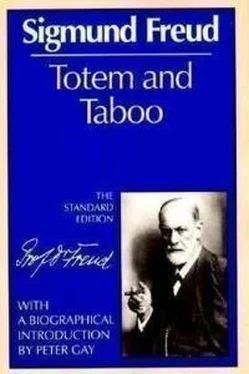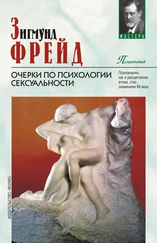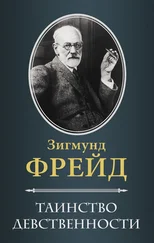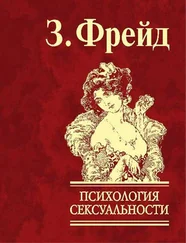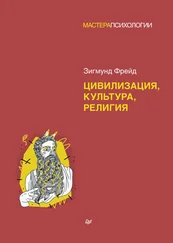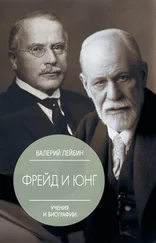Зигмунд Фрейд - Totem and Taboo
Здесь есть возможность читать онлайн «Зигмунд Фрейд - Totem and Taboo» весь текст электронной книги совершенно бесплатно (целиком полную версию без сокращений). В некоторых случаях можно слушать аудио, скачать через торрент в формате fb2 и присутствует краткое содержание. Год выпуска: 2014, Издательство: epubBooks Classics, Жанр: Психология, на английском языке. Описание произведения, (предисловие) а так же отзывы посетителей доступны на портале библиотеки ЛибКат.
- Название:Totem and Taboo
- Автор:
- Издательство:epubBooks Classics
- Жанр:
- Год:2014
- ISBN:нет данных
- Рейтинг книги:3 / 5. Голосов: 1
-
Избранное:Добавить в избранное
- Отзывы:
-
Ваша оценка:
- 60
- 1
- 2
- 3
- 4
- 5
Totem and Taboo: краткое содержание, описание и аннотация
Предлагаем к чтению аннотацию, описание, краткое содержание или предисловие (зависит от того, что написал сам автор книги «Totem and Taboo»). Если вы не нашли необходимую информацию о книге — напишите в комментариях, мы постараемся отыскать её.
Totem and Taboo — читать онлайн бесплатно полную книгу (весь текст) целиком
Ниже представлен текст книги, разбитый по страницам. Система сохранения места последней прочитанной страницы, позволяет с удобством читать онлайн бесплатно книгу «Totem and Taboo», без необходимости каждый раз заново искать на чём Вы остановились. Поставьте закладку, и сможете в любой момент перейти на страницу, на которой закончили чтение.
Интервал:
Закладка:
Totem and Taboo
Resemblances Between the Psychic Lives of Savages and Neurotics
Sigmund Freud
Author’s Preface
The essays treated here appeared under the subtitle of this book in the first numbers of the periodical Imago edited by me. They represent my first efforts to apply view–points and results of psychoanalysis to unexplained problems of racial psychology. In method this book contrasts with that of W. Wundt and the works of the Zurich Psychoanalytic School. The former tries to accomplish the same object through assumptions and procedures from non–analytic psychology, while the latter follow the opposite course and strive to settle problems of individual psychology by referring to material of racial psychology [1] Jung: Wandlungen and Symbole der Libido (Transformations and Symbols of the Libido) translated by Dr. Beatrice Hinkle under the title The Psychology of the Unconscious , and Principles of Psychoanalysis, Nervous and Mental Diseases .
. I am pleased to say that the first stimulus for my own works came from these two sources.
I am fully aware of the shortcomings in these essays. I shall not touch upon those which are characteristic of first efforts at investigation. The others, however, demand a word of explanation. The four essays which are here collected will be of interest to a wide circle of educated people, but they can only be thoroughly understood and judged by those who are really acquainted with psychoanalysis as such. It is hoped that they may serve as a bond between students of ethnology, philology, folklore and of the allied sciences, and psychoanalysts; they cannot, however, supply both groups the entire requisites for such co–operation. They will not furnish the former with sufficient insight into the new psychological technique, nor will the psychoanalysts acquire through them an adequate command over the material to be elaborated. Both groups will have to content themselves with whatever attention they can stimulate here and there and with the hope that frequent meetings between them will not remain unproductive for science.
The two principal themes, totem and taboo, which give the name to this small book are not treated alike here. The problem of taboo is presented more exhaustively, and the effort to solve it is approached with perfect confidence. The investigation of totemism may be modestly expressed as: “This is all that psychoanalytic study can contribute at present to the elucidation of the problem of totemism.” This difference in the treatment of the two subjects is due to the fact that taboo still exists in our midst. To be sure, it is negatively conceived and directed to different contents, but according to its psychological nature, it is still nothing else than Kant’s ‘Categorical Imperative’, which tends to act compulsively and rejects all conscious motivations. On the other hand, totemism is a religio–social institution which is alien to our present feelings; it has long been abandoned and replaced by new forms. In the religions, morals, and customs of the civilized races of to–day it has left only slight traces, and even among those races where it is still retained, it has had to undergo great changes. The social and material progress of the history of mankind could obviously change taboo much less than totemism.
In this book the attempt is ventured to find the original meaning of totemism through its infantile traces, that is, through the indications in which it reappears in the development of our own children. The close connection between totem and taboo indicates the further paths to the hypothesis maintained here. And although this hypothesis leads to somewhat improbable conclusions, there is no reason for rejecting the possibility that it comes more or less near to the reality which is so hard to reconstruct.
Translator’s Introduction
When one reviews the history of psychoanalysis [2] The History of the Psychoanalytic Movement , translated by A. A. Brill.
one finds that it had its inception in the study of morbid mental states. Beginning with the observation of hysteria and the other neuroses [3] Selected Papers on Hysteria and other Psychoneuroses , translated by A. A. Brill.
Professor Freud gradually extended his investigations to normal psychology and evolved new concepts and new methods of study. The neurotic symptoms were no longer imaginary troubles the nature of which one could not grasp, but were conceived as mental and emotional maladjustments to one’s environment. The stamp of degeneracy impressed upon neurotics by other schools of medicine was altogether eradicated. Deeper investigation showed conclusively that a person might become neurotic if subjected to certain environments, and that there was no definite dividing line between normal and abnormal. The hysterical symptoms, obsessions, doubts, phobias, as well as hallucinations of the insane, show the same mechanisms as those similar psychic structures which one constantly encounters in normal persons in the form of mistakes in talking, reading, writing, forgetting [4] The Psychopathology of Everyday Life , translated by A. A. Brill.
, dreams and wit. The dream, always highly valued by the populace, and as much despised by the educated classes, has a definite structure and meaning when subjected to analysis. Professor Freud’s monumental work, The Interpretation of Dreams [5] Translated by A. A. Brill.
, marked a new epoch in the history of mental science. One might use the same words in reference to his profound analysis of wit [6] Wit and Its Relations to the Unconscious , translated by A. A. Brill.
.
Faulty psychic actions, dreams and wit are products of the unconscious mental activity, and like neurotic or psychotic manifestations represent efforts at adjustment to one’s environment. The slip of the tongue shows that on account of unconscious inhibitions the individual concerned is unable to express his true thoughts; the dream is a distorted or plain expression of those wishes which are prohibited in the waking states, and the witticism, owing to its veiled or indirect way of expression, enables the individual to obtain pleasure from forbidden sources. But whereas dreams, witticisms, and faulty actions give evidences of inner conflicts which the individual overcomes, the neurotic or psychotic symptom is the result of a failure and represents a morbid adjustment.
The aforementioned psychic formations are therefore nothing but manifestations of the struggle with reality, the constant effort to adjust one’s primitive feelings to the demands of civilization. In spite of all later development the individual retains all his infantile psychic structures. Nothing is lost; the infantile wishes and primitive impulses can always be demonstrated in the grown–up and on occasion can be brought back to the surface. In his dreams the normal person is constantly reviving his childhood, and the neurotic or psychotic individual merges back into a sort of psychic infantilism through his morbid productions. The unconscious mental activity which is made up of repressed infantile material for ever tries to express itself. Whenever the individual finds it impossible to dominate the difficulties of the world of reality there is a regression to the infantile, and psychic disturbances ensue which are conceived as peculiar thoughts and acts. Thus the civilized adult is the result of his childhood or the sum total of his early impressions; psychoanalysis thus confirms the old saying: The child is father to the man.
It is at this point in the development of psychoanalysis that the paths gradually broadened until they finally culminated in this work. There were many indications that the childhood of the individual showed a marked resemblance to the primitive history or the childhood of races. The knowledge gained from dream analysis and phantasies [7] Freud: Leonardo Da Vinci , translated by A. A. Brill.
, when applied to the productions of racial phantasies, like myths and fairy tales, seemed to indicate that the first impulse to form myths was due to the same emotional strivings which produced dreams, fancies and symptoms [8] Cf. the works of Abraham, Spielrein, Jung, and Rank.
. Further study in this direction has thrown much light on our great cultural institutions, such as religion, morality, law and philosophy, all of which Professor Freud has modestly formulated in this volume and thus initiated a new epoch in the study of racial psychology.
Интервал:
Закладка:
Похожие книги на «Totem and Taboo»
Представляем Вашему вниманию похожие книги на «Totem and Taboo» списком для выбора. Мы отобрали схожую по названию и смыслу литературу в надежде предоставить читателям больше вариантов отыскать новые, интересные, ещё непрочитанные произведения.
Обсуждение, отзывы о книге «Totem and Taboo» и просто собственные мнения читателей. Оставьте ваши комментарии, напишите, что Вы думаете о произведении, его смысле или главных героях. Укажите что конкретно понравилось, а что нет, и почему Вы так считаете.
